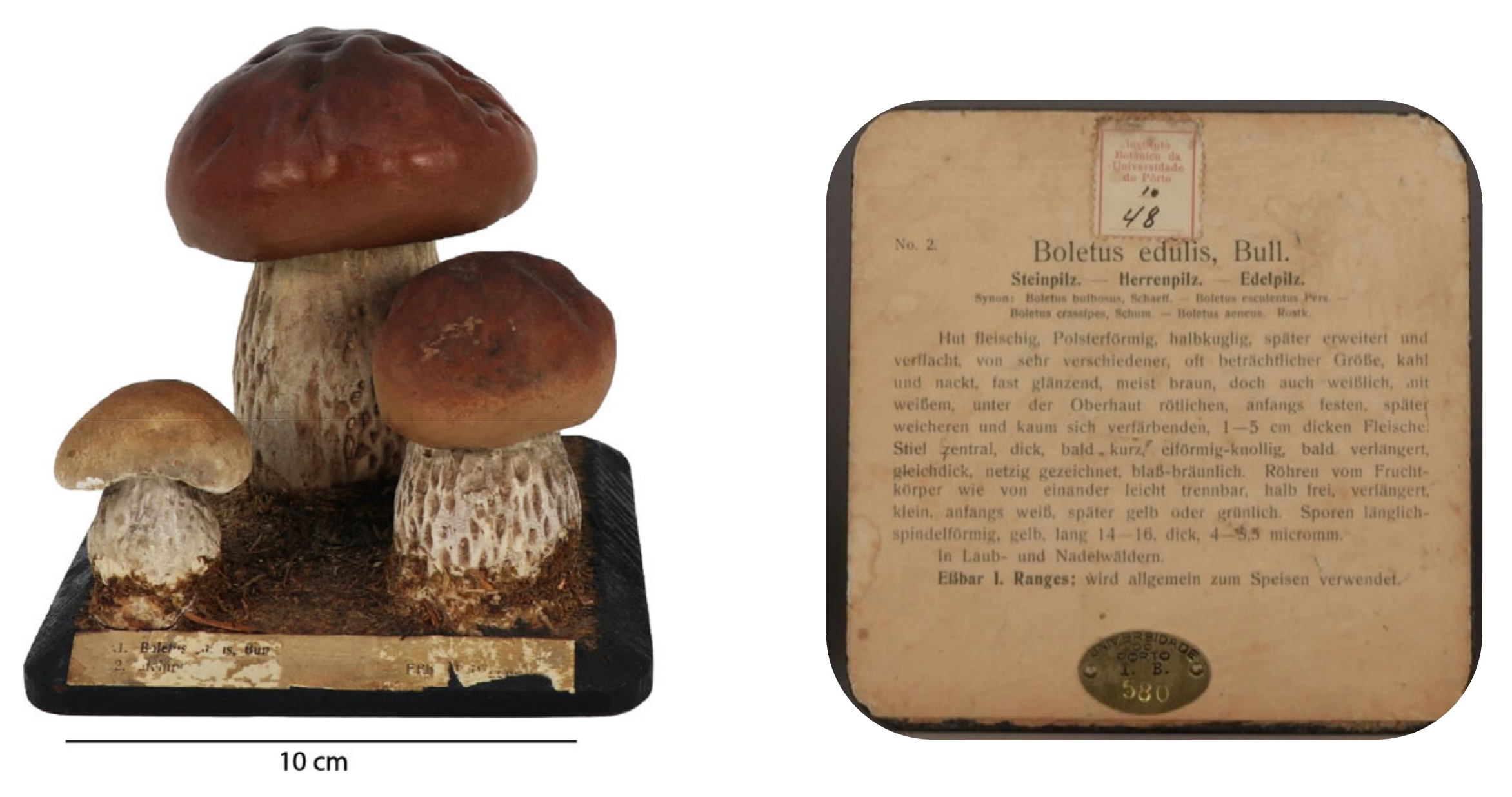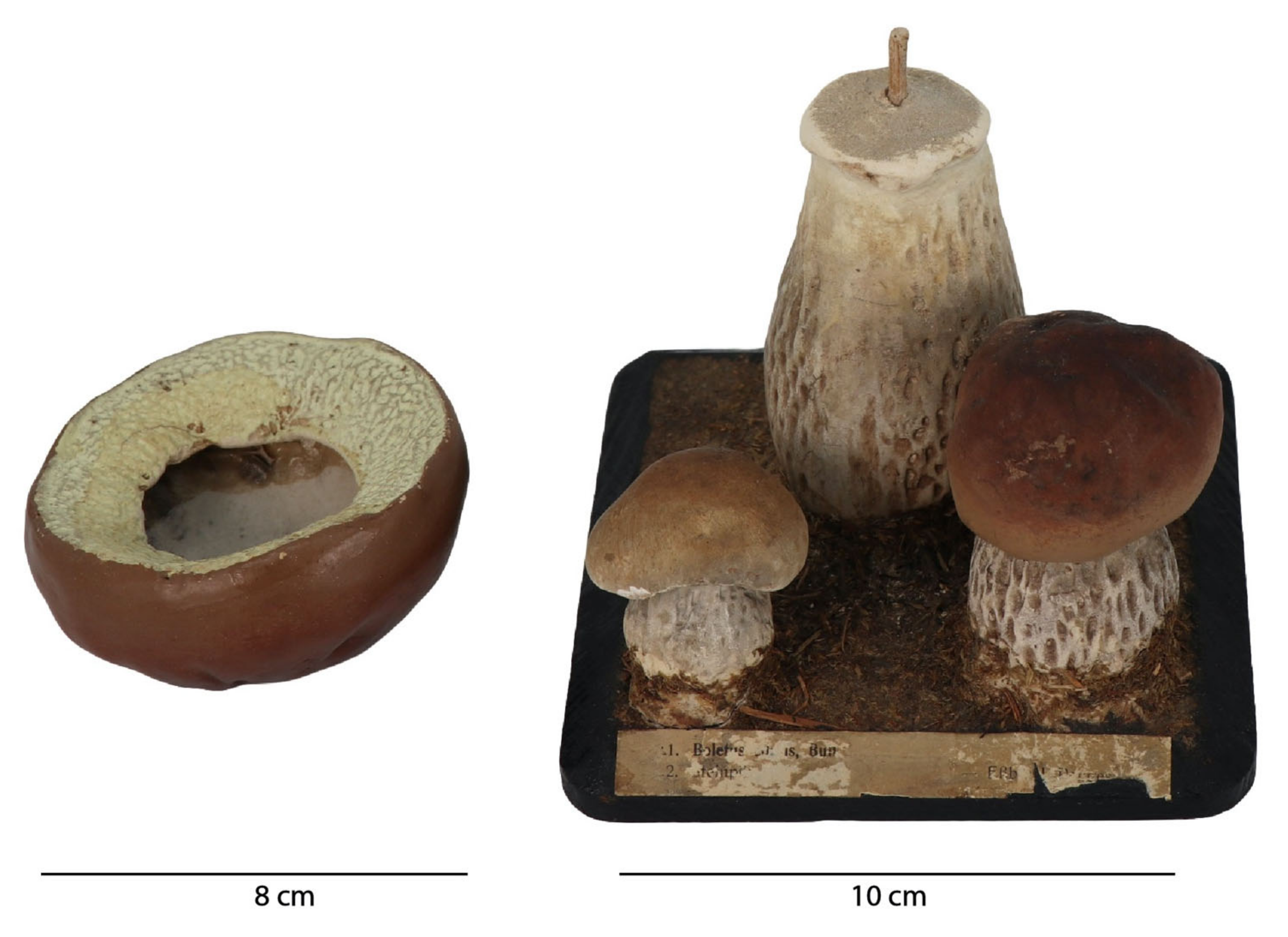Study of the Materials and Techniques of a Rare Papier-Mâché Mushroom Model Crafted in H. Arnoldi Factory
Abstract
:1. Introduction
1.1. Didactic Arnoldi’s Collection of Mushroom Models at the University of Porto Herbarium
1.1.1. Rationale for the Study
1.1.2. Arnoldi Manufacture
1.2. The Materials and Techniques Used in the Production of 19th-Century Didactic Models in Papier-Mâché
1.3. An In-Depth Study of the Materials of the Boletus edulis Didactic Model Using a Multi-Analytical Approach
2. Results and Discussion
2.1. Visual Description and Condition of the Boletus edulis Didactic Model
2.2. Analysis of the Papier-Mâché
2.2.1. The Fibers under the Microscope
2.2.2. Molecular Characterization
2.3. Characterization of the Colors Used in the Boletus edulis
2.4. Study of the Quadrangular Black Base
3. Materials and Methods
3.1. The University of Porto Herbarium and Visual Overview of the Condition of the 45 Models of Arnoldi’s Mushroom Collection
3.2. Points of Analysis for Boletus edulis Didactic Model and Micro-Samples for Infrared and Raman Analyses
3.3. Reference Samples Used in this Work
3.4. Energy-Dispersive X-ray Fluorescence Spectroscopy (microXRF)
3.5. Micro-Fourier Transform Infrared Spectroscopy
3.6. Raman Spectroscopy
3.7. Characterization of Paper Pulp Types
3.8. Analysis of the Presence of Fungi
4. Conclusions
Supplementary Materials
Author Contributions
Funding
Acknowledgments
Conflicts of Interest
Appendix A
Appendix B
References
- Arnoldi, H. Inhalts-Verzeichniss und Verkaufspreise der Naturgetreuen, Plastisch-Nachgebildeten Früchte und Pilze von H. Arnoldi. Fabrik künstlicher Früchte und Pilze. Gotha (Gegründet im Jabre 1865). NO. 1; Fabrik künstlicher Früchte und Pilze: Gotha, Germany, 1865. [Google Scholar]
- Academia Politécnica do Porto. Annuário da Academia Polytechnica do Porto, Anno Lectivo de 1881–1882; Typographia Central: Porto, Portugal, 1882. [Google Scholar]
- Vieira, C.; Muchagata, J.; Gaspar, R.; Gonçalves, H.; Mateus, S.; Fonseca, M.J. Biological models and replicas in Museu de História Natural e da Ciência da Universidade do Porto, Portugal. Arch. Nat. Hist. 2022, 49, 269–284. [Google Scholar] [CrossRef]
- Pungaršek, Š.; Piltaver, A.H. Arnoldi’s fungi models in the Slovenian museum of natural history and their documentation. Scopolia 2018, 92, 1–202. [Google Scholar]
- Ostertag-Henning, K.-L. Modellfrüchte–wächserne Kostbarkeiten der Pomologen. Zandera 2000, 15, 55–65. [Google Scholar]
- Cocks, M.M. Dr Louis Auzoux and his collection of papier-mâché flowers, fruits and seeds. J. Hist. Collect. 2014, 26, 229–248. [Google Scholar] [CrossRef]
- Manso, M.; Bidarra, A.; Longelin, S.; Pessanha, S.; Ferreira, A.; Guerra, M.; Coroado, J.; Carvalho, L. Micro-Analytical Study of a Rare Papier-Mâché Sculpture Microsc. Microanal. 2015, 21, 56–62. [Google Scholar] [CrossRef] [PubMed] [Green Version]
- Ward, G.W.R. (Ed.) The Grove Encyclopedia of Materials and Techniques in Art; Oxford University Press: Oxford, UK, 2008. [Google Scholar]
- Bardt, J. Kunst aus Papier: Zur Ikonographie eines Plastischen Werkmaterials der Zeitgenössischen Kunst; Olms: Hildesheim, Germany, 2016. [Google Scholar]
- Mayoni, M.G. Plantas de papier-mâché. Estudios técnicos y conservación de la colección Brendel del Colegio Nacional de Buenos Aires. Argentina. Ge-conservación 2016, 9, 6–20. [Google Scholar] [CrossRef]
- Poliszuk, A.; Ybarra, G. Analysis of cultural heritage materials by infrared spectroscopy. In Infrared Spectroscopy: Theory, Developments and Applications; Nova Science Publishers: Hauppauge, NY, USA, 2014; pp. 519–536. [Google Scholar]
- Otero, V.; Carlyle, L.; Vilarigues, M.; Melo, M.J. Chrome yellow in nineteenth century art: Historic reconstructions of an artists’ pigment. RSC Adv. 2012, 2, 1798–1805. [Google Scholar] [CrossRef]
- Montagner, C.; Sanches, D.; Pedroso, J.; Melo, M.J.; Vilarigues, M. Ochres and earths: Matrix and chromophores characterization of 19th and 20th century artist materials. Spectrochim. Acta Part A Mol. Biomol. Spectrosc. 2013, 103, 409–416. [Google Scholar] [CrossRef]
- Biermann, C.J. Handbook of Pulping and Papermaking, 2nd ed.; Academic Press: San Diego, CA, USA, 1996; p. 62. [Google Scholar]
- Llvessalo-Pfaffli, M.-S. Fiber Atlas: Identification of Papermaking Fibers; Timell, T.E., Ed.; Springer: New York, NY, USA, 1995; pp. 308–326. [Google Scholar]
- Hunter, D. Papermaking: The History and Technique of an Ancient Craft; Dover Publications: New York, NY, USA, 1978; p. 395. [Google Scholar]
- Pereira, A.I. The Perfect Paint in Modern Art Conservation. A Comparative Study of 21st Century Vinyl Emulsions. PhD. Thesis, NOVA School of Science and Technology, Caparica, Portugal, 20 February 2015; pp. 55–56. [Google Scholar]
- Al Saedi, J.K.; Alalawy, R.D.; Hasan, N.M. Determination the concentration elements of cultivation media (peat moss, perlite and hormone) using X-ray fluorescence technique. Iraqi J. Sci. 2018, 59, 1769–1777. [Google Scholar]
- Miguel, C.; Lopes, J.A.; Clarke, M.; Melo, M.J. Combining infrared spectroscopy with chemometric analysis for the characterization of proteinaceous binders in medieval paints. Chemometr. Intell. Lab. 2012, 119, 32–38. [Google Scholar] [CrossRef]
- Doyle, B.B. Infrared Spectroscopy of Collagen and Collagen-Like Polypeptides. Biopolymers 1975, 14, 937–957. [Google Scholar] [CrossRef] [PubMed]
- Melo, M.J.; Nabais, P.; Araújo, R.; Vitorino, T. The conservation of medieval manuscript illuminations: A chemical perspective. Phys. Sci. Rev. 2019, 4, 20180017. [Google Scholar] [CrossRef]
- TAPPI. Fiber Analysis of Paper and paperboard–T 401; Technical Association of the Pulp and Paper Industry: Atlanta, GA, USA, 2008. [Google Scholar]










Disclaimer/Publisher’s Note: The statements, opinions and data contained in all publications are solely those of the individual author(s) and contributor(s) and not of MDPI and/or the editor(s). MDPI and/or the editor(s) disclaim responsibility for any injury to people or property resulting from any ideas, methods, instructions or products referred to in the content. |
© 2023 by the authors. Licensee MDPI, Basel, Switzerland. This article is an open access article distributed under the terms and conditions of the Creative Commons Attribution (CC BY) license (https://creativecommons.org/licenses/by/4.0/).
Share and Cite
Melo, M.J.; Freitas, A.; Vieira, C.; Vilarigues, M.; Vieira, M.; Nabais, P.; Sequeira, S.; Lourenço, M.; Oliveira, G.; Correia, A.R. Study of the Materials and Techniques of a Rare Papier-Mâché Mushroom Model Crafted in H. Arnoldi Factory. Molecules 2023, 28, 1062. https://doi.org/10.3390/molecules28031062
Melo MJ, Freitas A, Vieira C, Vilarigues M, Vieira M, Nabais P, Sequeira S, Lourenço M, Oliveira G, Correia AR. Study of the Materials and Techniques of a Rare Papier-Mâché Mushroom Model Crafted in H. Arnoldi Factory. Molecules. 2023; 28(3):1062. https://doi.org/10.3390/molecules28031062
Chicago/Turabian StyleMelo, Maria J., Ana Freitas, Cristiana Vieira, Márcia Vilarigues, Márcia Vieira, Paula Nabais, Sílvia Sequeira, Mónica Lourenço, Gabriel Oliveira, and Ana Rita Correia. 2023. "Study of the Materials and Techniques of a Rare Papier-Mâché Mushroom Model Crafted in H. Arnoldi Factory" Molecules 28, no. 3: 1062. https://doi.org/10.3390/molecules28031062
APA StyleMelo, M. J., Freitas, A., Vieira, C., Vilarigues, M., Vieira, M., Nabais, P., Sequeira, S., Lourenço, M., Oliveira, G., & Correia, A. R. (2023). Study of the Materials and Techniques of a Rare Papier-Mâché Mushroom Model Crafted in H. Arnoldi Factory. Molecules, 28(3), 1062. https://doi.org/10.3390/molecules28031062







